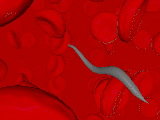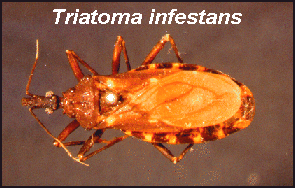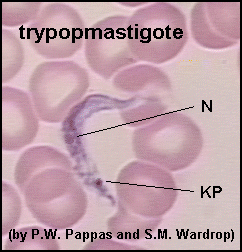

From the southern parts of the United States through Mexico and Central America, and in South America as far south as Argentina, various wild rodents, opossums, and armadillos may be found infected with a trypanosome that is also capable of producing disease in humans. the organism was first found in the reduviid bug Panstrongylus megistus and later in humans, by the Brazilian worker Carlos Chargas while he was still a medical student; in his honor the disease was named. Chagas' disease is caused byT. cruzian organism that differs from other trypanosomes infecting humans in that it has an intracellular amastigote stage in cardiac muscle and other tissues. the trypomastigots are found in the blood stream.
Human got infected by feces of infected reduviid bug (Triatoma and others).

The fecal doppings from this insect can easily transport the parasite to susceptible entry in the human body such as eyes, mucus membranes and open wounds. The symptom of this stage is swelling around the eyes, and this is a common result of infection and marks the point of entry.

This is the fecal dropping, amastigote (Dividing Stage, intracellular in tissues). It burrows into the cell and multiplies unhindered by the immune system.
Few days later amastigote become trypomastigote,it kills the host cell. New born parasites reenter the bloodstream where they go on to infect other cells. Triatomic bug deeding on human blood become infected and thus complete the life cycle of the organism. The symptoms of this stage are fever, malaise enlarged glands, and hepatosplenomegaly. When the infection occur in the infants, trypomastigotes or parasites are found in the blood in considerable numbers; however, they are usually sparse in patients older than 1 year.

The trypomastigotes average 20 um in length, slender form. The nucleus (N) is usually positioned centrally and the large oval kinetoplast (KP) is located posteriorly.
The disease is seen in its most severe and common form, in children younger than 5 years, and predominantly in whom symptoms of central nervous system involvement, respectively. In older children and adults the disease usually occurs in milder, subacute or chronic form, which generally follows an acute attack.
Symptoms of generalized infection may appear from 4 days to 2 weeks or more after the bite. Generalized malaise; chills; high fever; which may continuous, intermittent, or remittent; muscle aches and pains; and increasing exhaustion characterized the acute stage. Epistaxis is common in young children. Generalized glandular enlargement occurs in the early stage of infection; amastigotes may be found in any enlarged lymph node that drain the chagoma. The liver amy be felt several finger breadths below the costal margin. A rash may make its appearance approximately 2 weeks after infection. Pinhead'sized, well'defined red spots, appearing on chest and abdomen, are neither painful nor pruritic and fade in 7 to 10 days.
One of the choices of drug in treatment of Chagas' disease is the nitrofurfurylidine derivative nifurtimox (Lampit, also known as Bayer 2502), which inhibits intracellular development ofT. cruziin the tissue culture. It is better tolerated by young than older patients.
Another choice is Benznidazole which has been used in Argentina, Brazil, and Chile since 1971. The main side effects are skin allergy and peripheral neuropathy. The mode of action of this drug is to inhibit the nucleic acid synthesis. However, this drug is not available in The United States.
For more information about the treatments:
The recent molecular Cure T.cruzi is found by Dr.Faerman and Dr. Gellilan from Cornell Biochemistry and Theory Center. It is called Trypanothione. The T.cruzi parasite depends heavily upon this molecule to protect itself against damage from oxygen free radicals produced during normal metabolism. Tyrpanothione reductase (TR) maintained the concentrion of trypanothione in the cell. Drugs that incapacitate TR should cause the parasite to die. In human cell, there are a set of similar molecules: glutathione and glutathione reductase (GR). Fortunately, the enzyme GR has the opposite electrostatic sharge of TR so there is hope of developing a drug that will be safe for human cells.
 Bibliography
Bibliography
 This page was created by Tiffanie Huynh
This page was created by Tiffanie Huynh
The following has been added by the Electronic Desktop Project:
 Contact Us
Contact UsIf you are an educator who is using our NEXTSTEP or virtual applications in the classroom, we would especially like to hear from you. Let us know what you are doing and how it is working out. Continued support for this project will depend on its impact in science education.
If you are an educator who is interested in making use of our NEXTSTEP or virtual applications, please let us know how we can help.
 Return to the Electronic Desktop Project home page
Return to the Electronic Desktop Project home page
![]() Check out the WWW Virtual Application Catalog from the EDP
Check out the WWW Virtual Application Catalog from the EDP
 Check out the NEXTSTEP Application Catalog from the EDP
Check out the NEXTSTEP Application Catalog from the EDP
 Visit the home page for California State University, Los Angeles
Visit the home page for California State University, Los Angeles